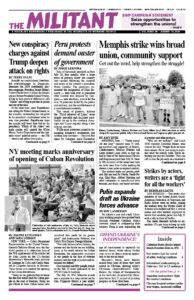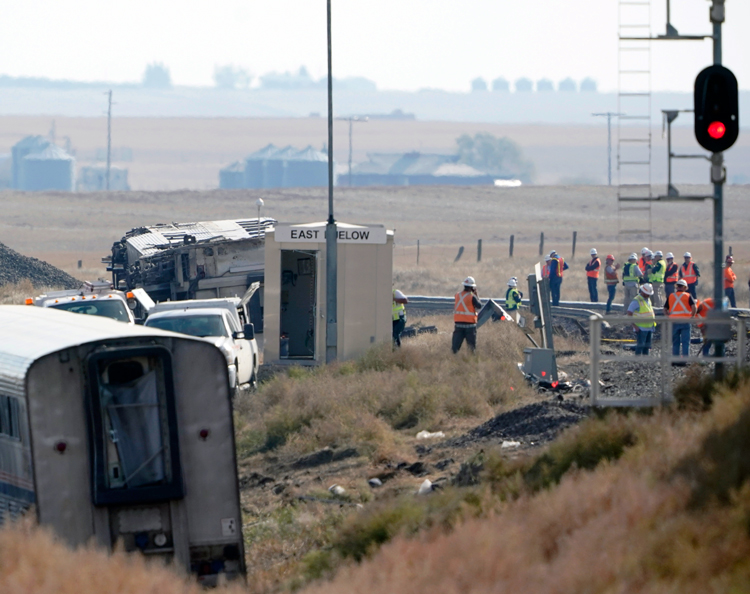LINCOLN, Neb. — There are thousands of rural towns across the U.S. crisscrossed by railroad tracks where trains pass through daily. Since the Feb. 3 Norfolk Southern derailment and burn-off of some 900,000 pounds of toxic vinyl chloride in East Palestine, Ohio, workers and farmers near rail tracks nationwide have become increasingly concerned about their situation.
Their concerns are shared by rail workers, who are looking for ways to take control over safety and work conditions.
A number of working people in and around Camanche, Iowa, located on the banks of the Mississippi River, were interviewed in July by Grist, an online magazine. “You feel for those people” of East Palestine, Alice Srp said July 12, “but your heart is thinking, are we going to be next?”
Some displaced East Palestine residents are unable to return to their homes six months after the disaster there, while others still face contaminated soil and streams in the town. Many attend meetings demanding the Environmental Protection Agency and other government agencies do something about the symptoms that are related to the chemical spills, while officials drag their feet.
U.S. railroads move over 2 million cars of hazardous materials annually.
Many homes in Camanche are located between the tracks and the river. “Roughly 1,000 people on the river side of the tracks are without help when trains pass through,” said Kitt Swanson. The only way out for her and others then is by boat.
Swanson, who is diabetic, said, “If I need EMS care, how am I going to get it when all the tracks are blocked?”
The rail line there belongs to Canadian Pacific, which purchased Kansas City Southern in April for $31 billion. Working people there see around eight trains a day now, but the merger means traffic will swell. People in the city of 4,500 are expected to see upward of 21 trains rolling through every day.
Bosses drive for profits guts safety
Other recent derailments underscore how the rail bosses’ thirst for profits has led to increasingly dangerous conditions facing rail workers and working people along the tracks. Last week the National Transportation Safety Board concluded that an Amtrak derailment that killed three passengers and injured 49 others in Montana in 2021 was the result of tracks that were not properly maintained and inspected by BNSF Railway.
The situation faced by the track inspector assigned to that area, from cutbacks in personnel and the increased workload forced on those left, the NTSB said, probably “prevented him from performing a timely walking inspection of the track.” When he inspected the curve where the derailment took place two days earlier, he was responsible for inspecting 126.8 miles of track. Two days later the Amtrak train derailed, the report said.
The report says BNSF’s lack of “safety culture” was tied to high workloads and fatigue.
After heavy rain and flooding, a Norfolk Southern train drove over a sinkhole in the Philadelphia suburbs July 17, derailing 15 cars. Some cars on the train carried hazardous chemicals, but luckily none of those hit the ground. While the bosses tried to blame the derailment on “climate change,” in all likelihood the railroad took a chance and didn’t send an inspector out to check the tracks.
“The problem is the railroad bosses are too willing to take a chance to keep the trains moving instead of sending track inspectors ahead of the train to check the track for washouts, sinkholes, and kinking of the trackage following heavy rain storms,” Jakob Forsgren, a Lincoln-based track worker and member of the Brotherhood of Maintenance of Way Employees, told the Militant, “all for the reasons of profit over safety.”
“When I was a track-work inspector, it was an absolute practice during a heavy storm that the dispatcher would stop all movement of trains until the inspectors and signal maintainers had checked the trackage and reported it was safe,” Paul Swanson, a retired Denver area BMWE member, told the Militant.
One factor rail workers point to in derailments today is the vastly increased length and tonnage of freight trains. The bosses push this relentlessly to reduce crews and boost profits. At the same time, they’re fighting rail unions to be able to cut train crews to just one worker.
Under increasing pressure from the East Palestine derailment, and from public actions by rail workers and their unions as well as residents in that area, some government agencies have called for new measures.
In late July, the Federal Railroad Administration pointed to East Palestine and urged Class I railroads to file monthly reports on the number, length, weight and consist of every train operated on their rail lines.
“When you are running 12,000- to 14,000-foot trains, and my conductor has only five months training, let alone being trained properly,” you raise questions, Randy Pitts, a SMART-TD union local chair, said at an NTSB hearing on the East Palestine derailment in April, describing experiences he has had.
“When you have a general manager specifically tell a division superintendent, ‘I don’t care whether they’re trained fully or not, mark them up, promote them, we’ve got to get these trains across the road,’” Pitts said.
Reliance on the bosses, government regulators or anyone beside rail workers ourselves, backed by the power of the labor movement, will not get the job done. We need to prepare to use union power, to fight for workers control over safety, and to reach out and win solidarity from other unionists and the working-class public. This is the only road to win safer, larger crew size, shorter trains and control over working conditions.
Joe Swanson is a retired rail conductor and remains active in his SMART-TD union local.


